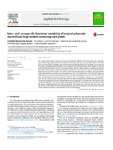Use este identificador para citar ou linkar para este item:
http://www.alice.cnptia.embrapa.br/alice/handle/doc/985004Registro completo de metadados
| Campo DC | Valor | Idioma |
|---|---|---|
| dc.contributor.author | NOVAIS, C. B. de | pt_BR |
| dc.contributor.author | BORGES, W. L. | pt_BR |
| dc.contributor.author | JESUS, E. da C. | pt_BR |
| dc.contributor.author | SAGGIN JUNIOR, O. J. | pt_BR |
| dc.contributor.author | SIQUEIRA, J. O. | pt_BR |
| dc.date.accessioned | 2014-04-23T11:11:11Z | pt_BR |
| dc.date.available | 2014-04-23T11:11:11Z | pt_BR |
| dc.date.created | 2014-04-23 | pt_BR |
| dc.date.issued | 2014 | pt_BR |
| dc.identifier.citation | Applied Soil Ecology, Amsterdam, v. 76, p. 78-76, 2014. | pt_BR |
| dc.identifier.uri | http://www.alice.cnptia.embrapa.br/alice/handle/doc/985004 | pt_BR |
| dc.description | For a single plant species under the same environmental conditions, the interaction with arbuscularmycorrhizal fungi (AMF) and their contribution to plant growth varies among AMF isolates, with bothinter and intraspecific variability. The present study evaluated the functional variability of 41 isolates of20 species and eight genera of AMF for root colonization, growth promotion, and P uptake of corn andobserved the relationship of this functional variability with the isolates genetic variability revealed byPCR-RFLP analysis. All the isolates abundantly colonized the corn roots, but only 23 promoted highershoot dry mass and P leaf content. The cluster analysis based on functional variability data separated theisolates Acaulospora morrowiae (Am2), Acaulospora sp. (Aca), A. colombiana (Ac3, Ac4, and Ac5), Gigasporaalbida (Gia1), Gi. margarita (Gim4 and Gim5), Gi. rosea (Gir), Rhizophagus clarus (Rc2, Rc3, Rc4, Rc5, andRc6), Claroideoglomus etunicatum (Ce4), R. manihotis (Rm), Scutellospora calospora (Sc), S. heterogama(Sh2, Sh3, Sh4, and Sh5) and S. pellucida (Sp3) from the others at the distance of 80% functional similarity.These were considered efficient in promoting functional symbiosis in corn while the other isolates wereconsidered inefficient. The cluster analysis obtained by the PCR-RFLP technique was partly coherent withthe species classification based on spore morphology. The isolates of R. clarus fell into one cluster andthe isolates of the Gigaspora and Scutellospora genera (Gigasporaceae family) were clustered in a secondcluster, without the ability to separate the species of these genera. | pt_BR |
| dc.language.iso | eng | eng |
| dc.rights | openAccess | eng |
| dc.subject | Geographical isolates | pt_BR |
| dc.subject | RFLP | pt_BR |
| dc.title | Inter- and intraspecific functional variability of tropical arbuscularmycorrhizal fungi isolates colonizing corn plants. | pt_BR |
| dc.type | Artigo de periódico | pt_BR |
| dc.date.updated | 2019-05-29T11:11:11Z | pt_BR |
| dc.subject.nalthesaurus | Acaulospora | pt_BR |
| dc.subject.nalthesaurus | Glomus | pt_BR |
| dc.subject.nalthesaurus | Gigaspora | pt_BR |
| riaa.ainfo.id | 985004 | pt_BR |
| riaa.ainfo.lastupdate | 2019-05-29 -03:00:00 | pt_BR |
| dc.contributor.institution | WARDSSON LUSTRINO BORGES, CPAF-AP; EDERSON DA CONCEICAO JESUS, CNPAB; ORIVALDO JOSE SAGGIN JUNIOR, CNPAB. | pt_BR |
| Aparece nas coleções: | Artigo em periódico indexado (CPAF-AP)  | |
Arquivos associados a este item:
| Arquivo | Descrição | Tamanho | Formato | |
|---|---|---|---|---|
| CPAFAP2014Interandintraspecificfunctionalvariabilityoftropicalarbuscularmycorrhizal.pdf | 2,1 MB | Adobe PDF |  Visualizar/Abrir |









